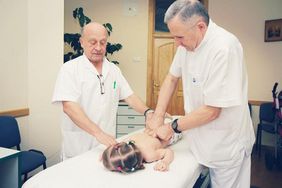Treatment is aimed at improving the child’s motor, cognitive and speech skills, normalising muscle tone, increasing the active and passive range of motion, and improving blood circulation, metabolism and tissue trophics. The rehabilitation system is based on a multimodal principle involving different methods to impact the patient’s body. Each of these methods supplements and potentiates each other.
By stimulating the compensatory capabilities in the child’s body and activating brain plasticity, the INRS creates a new functional condition that opens a wide range of opportunities for the child’s motor and cognitive development.
The method includes consistent and long-term therapy, which is regularly scheduled in two alternate phases. Therapy duration is prescribed individually and depends on the patient’s age and somatic and psycho-neurological symptoms.
The intensive correction phase is carried out in a rehabilitation facility in 10 to 11 days.
It includes:
- A medical examination, video monitoring of gross motor skills, assessment of the child’s physical, cognitive, motor, speech, and social development before and after treatment.
- A basic set of therapeutic measures:
• Biomechanical correction of the spine
• Limb joint mobilization
• Reflexotherapy
• Mobilization exercises
• Special system
• Apitherapy - Taking into account the patient’s age, physical abilities and severity of the disease, the attending physician may also prescribe a number of additional individual procedures:
• Orofacial massage
• Gait correction on a treadmill
• Mechanotherapy
• Computer game therapy
• Vibration therapy
• Light therapy
Parents are actively involved in the rehabilitation process and learn practical physiotherapy skills and massage skills in order to continue working with the child at home.
The stabilization and potentiation phase is carried out by parents and family members or by local medical staff at the patient’s home or place of residence (in 3-6-12 months) in line with therapeutic recommendations. Taking into account the patient’s individual indicators, this rehabilitation programme may include hydrokinesis, swimming, ergotherapy, cycling, hippotherapy, dolphin therapy, etc.
The multi-faceted therapeutic effects of this method, mutually complementing and enhancing one another, are aimed at achieving the ultimate rehabilitation goal – to improve the quality of life for patients.

